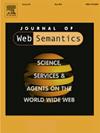The Musician’s Context Ontology: Modeling the context for smart musical applications
IF 3.1
3区 计算机科学
Q3 COMPUTER SCIENCE, ARTIFICIAL INTELLIGENCE
引用次数: 0
Abstract
The paradigm of context-aware computing allows storing situational and environmental information in such a way that its interpretation can be done easily and more meaningfully. In turn, this understanding is used to anticipate users’ needs, and proactively provide them with situation-aware content and experiences. Whereas context-awareness has been investigated extensively in the computer science and IoT disciplines, it has been largely overlooked by the research community dealing with musical interfaces design. Existing musical instruments are not equipped with the ability to understand the context around them, namely who is the musician playing them, what musical activity is being conducted, as well as where and when. Enhancing musical instruments with context-awareness has the concrete potential to enable novel kinds of interactions between musicians and musical content in a large variety of situations, from playing alone to playing in a group, from music learning to music composition. To accomplish such a vision of intelligence embedded in musical instruments it is necessary to model the context around their users. In this paper, we present an ontology devised to represent the knowledge related to musicians and musical activities, the “Musician’s Context Ontology” (MUSICO) to facilitate the development of context-aware musical applications. There was no previous comprehensive data model for the domain of musicians’ context, nevertheless, the new ontology relates to several existing ontologies, including the Internet of Musical Things Ontology to represent Internet of Musical Things ecosystems and the Music Ontology that deals with the description of the music value-chain from production to consumption. This paper documents the design of the ontology and its evaluation with respect to specific requirements gathered from an extensive literature review and interviews with musicians. The utility of the ontology is demonstrated by a smartphone application that enables to search for musicians based on both textual and content-based musical queries. MUSICO can be accessed at: https://w3id.org/musico#.
音乐家的语境本体:为智能音乐应用建模语境
上下文感知计算的范例允许以这样一种方式存储情景和环境信息,即可以轻松且更有意义地对其进行解释。反过来,这种理解被用来预测用户的需求,并主动为他们提供情境感知的内容和体验。虽然上下文感知在计算机科学和物联网学科中得到了广泛的研究,但在处理音乐界面设计的研究社区中,它在很大程度上被忽视了。现有的乐器不具备理解周围环境的能力,即演奏它们的音乐家是谁,正在进行什么音乐活动,以及何时何地。通过上下文感知来增强乐器,有可能使音乐家和音乐内容在各种情况下进行新颖的互动,从单独演奏到团队演奏,从音乐学习到音乐创作。为了实现这种嵌入乐器的智能愿景,有必要围绕它们的用户对环境进行建模。在本文中,我们提出了一个本体来表示与音乐家和音乐活动相关的知识,即“音乐家的上下文本体”(MUSICO),以促进上下文感知音乐应用程序的开发。音乐家背景领域之前没有全面的数据模型,然而,新的本体涉及到几个现有的本体,包括代表音乐物联网生态系统的音乐物联网本体和处理从生产到消费的音乐价值链描述的音乐本体。本文记录了本体的设计及其对从广泛的文献综述和对音乐家的采访中收集的具体要求的评估。通过一个智能手机应用程序演示了本体的实用性,该应用程序可以基于文本和基于内容的音乐查询来搜索音乐家。MUSICO网站可以访问:https://w3id.org/musico#。
本文章由计算机程序翻译,如有差异,请以英文原文为准。
求助全文
约1分钟内获得全文
求助全文
来源期刊

Journal of Web Semantics
工程技术-计算机:人工智能
CiteScore
6.20
自引率
12.00%
发文量
22
审稿时长
14.6 weeks
期刊介绍:
The Journal of Web Semantics is an interdisciplinary journal based on research and applications of various subject areas that contribute to the development of a knowledge-intensive and intelligent service Web. These areas include: knowledge technologies, ontology, agents, databases and the semantic grid, obviously disciplines like information retrieval, language technology, human-computer interaction and knowledge discovery are of major relevance as well. All aspects of the Semantic Web development are covered. The publication of large-scale experiments and their analysis is also encouraged to clearly illustrate scenarios and methods that introduce semantics into existing Web interfaces, contents and services. The journal emphasizes the publication of papers that combine theories, methods and experiments from different subject areas in order to deliver innovative semantic methods and applications.
 求助内容:
求助内容: 应助结果提醒方式:
应助结果提醒方式:


